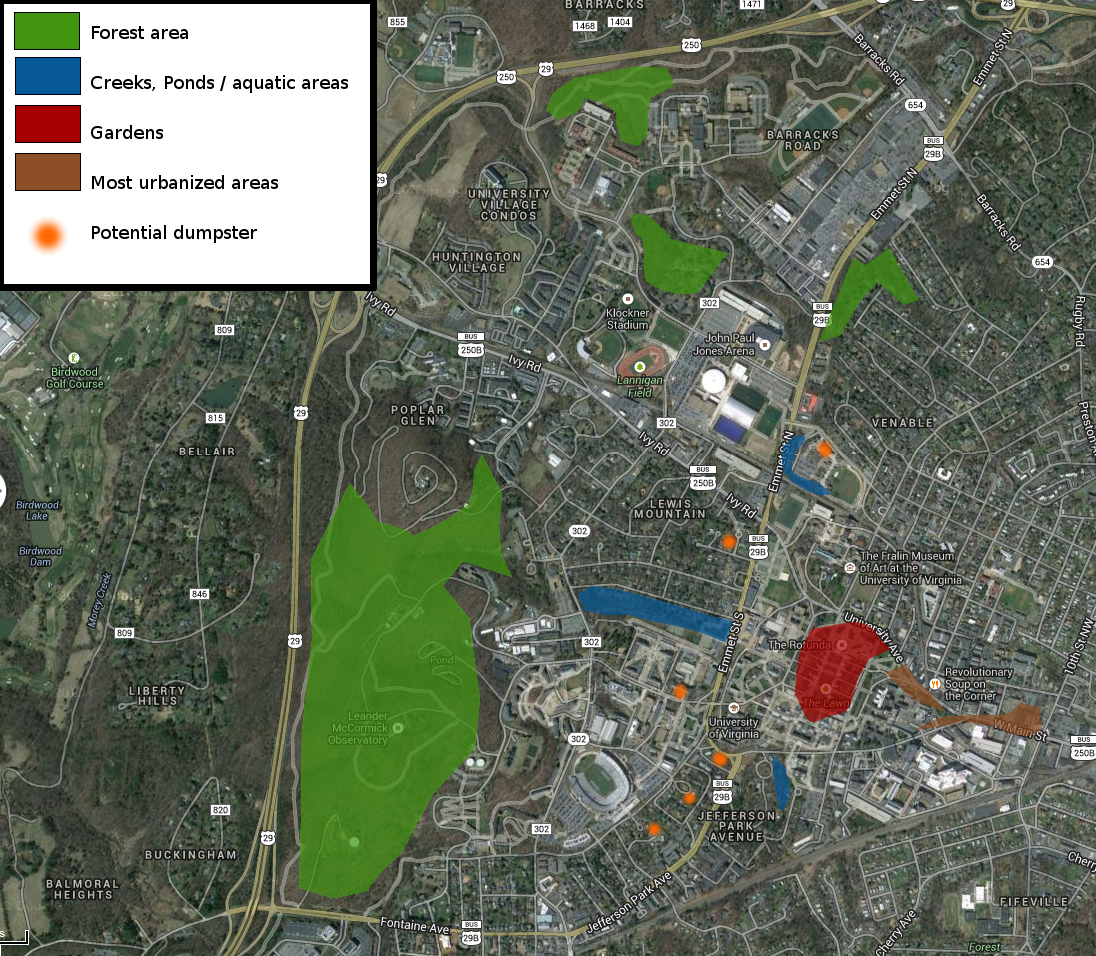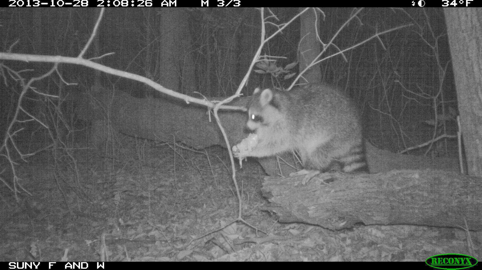The job of the Nocturnal Life team is to gather information on the animals that can be found on UVa grounds at night. The nocturnal fauna is more diverse and numerous than most people think; indeed, it is easy to miss it, because it’s most active at times when humans sleep (or stay inside) and because as diurnal creatures, we’re not very good at seeing what happens in the dark. And yet, a lot happens. Some signs might be found in the morning by those who know what to look for: tracks, animal waste, etc. Studying the nocturnal fauna of our University brings us a new insight on the vast biodiversity of grounds and the complexity of the ecosystem we live in.
Our goal is to accumulate data on what animals go out at night, and to determinate where and when they might be found. The best way for us to do so is by taking pictures of animals at night using camera traps. These are special cameras meant to be disposed outside (they’re waterproof, have a long battery life etc.). They have “night vision” – meaning they can take pictures in the dark – and are movement-activated. So basically, the idea is just to place them in a strategic place, wait for an animal to walk in front of them and come get the photos in the morning. As I’m writing this blog post, we haven’t received the cameras yet. The University has promised us five of them, and we should start taking pictures in the next few days. What we have done right now is set up our plan of action and methodology.
Where should the cameras be?
We first decided which were the best locations to set up our camera traps on. UVa grounds includes a lot of different environments with different potential fauna. Five cameras is enough for us to get pictures of various places, but not enough that we don’t have to be careful in positioning them.
Forest – When speaking of wildlife, the most obvious kind of area would be a woodland. There are a few wooded areas on grounds, the largest being Observatory Hill/Mount Jefferson around the McCormick Observatory, north/north-west of Hereford and in the Poplar Glen neighborhood. There are also small chunks of forest near Fontaine Research Park, in several places of North Grounds near the Law School and Lambeth Residential Area.
Near the water – We think it would be interesting to set up a camera or two close to the aquatic areas on grounds. There is the Pond, the Dell and the portion of Meadow Creek visible near the old dormitories or near Lambeth. Placing cameras here would maybe help us see animals that came to drink, birds, or aquatic fauna (like frogs).
The gardens – The various gardens near the Lawn and all around Central Grounds are definitely a good spot for us. They could give us insight on the nocturnal fauna of a densely built/inhabited area of grounds. Maybe we could find some bats here?
Urbanized places – near the hospital or in more urbanized places of grounds (near West Main Street, the gardens close to the Corner, etc.), we might try to see if there’s a kind of fauna that dwells near human activities. Maybe cats, mice, rats, and other semi-symbiotic species.
The dumpsters – everybody knows squirrels like to feast in the various dumpster across grounds, like near the IRC. Other animals might be sighted there at night, especially racoons or groundhogs.
Technical aspects
Finding good spots for the cameras is one thing, but it’s not everything. A lot of technical details must be taken into account. We contacted the expert researcher on Portland State University nocturnal fauna, Leslie Bliss-Ketchum, and she gave us some advice. The angle at which we place the cameras seems to be extremely important: it could determine whether we get a lot of pictures, or none at all. Leslie suggested that we lure animals, at least in the beginning, by placing oats and peanut butter on the ground near the cameras – so that we may see whether the angle we chose worked or not. We’ll also need to secure the cameras against potential theft and relocation, especially in public areas.
One of the aspects of the project will also be to set up a routine of checking-up the cameras, relocating them, storing the pictures, etc. We’ll work as a team to split up the work of placing and fetching the cameras, especially in relatively remote/inaccessible places.
Objectives and final project
What we hope to get is a lot of pictures of the most diverse species group possible. With enough data, we should be able to place a species’ habitat on a map of UVa grounds, as well as distinguish patterns regarding the time of the night when they come out, if urban activities disrupt them, etc.
Our findings should be presented on an interactive map, where it would be possible to see which species lives where, and to see what photos was taken at what spot. Hopefully this will help raise awareness about the diversity and richness of the nocturnal fauna in our University.
Image credits
Camera trap: http://bioventuraecoturismoanimal.files.wordpress.com/2011/08/moultrie-camera-trap-d401.jpg
Map: from http://maps.google.com and edited by Gabriel Poulain
Racoon: http://3.bp.blogspot.com/-enU0WSSk_Gs/UnkyYgkR6lI/AAAAAAAAMsY/mdKzSj5sWaE/s1600/IMG_0120.JPG
Post by Gabriel Poulain, Third-Year, Political Science


